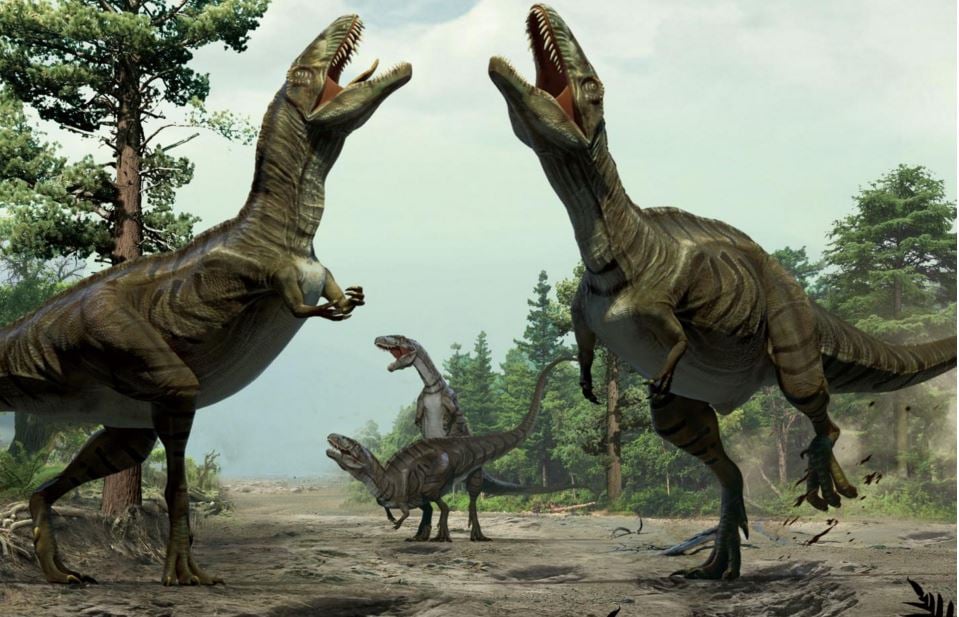Dinosaurs loved each other many millions of years ago much like birds do today, say scientists, who found evidence of prehistoric nest scrape ceremonies in western Colorado’s prehistoric Dakota sandstone. The male killdeer (type of plover), for example, scrapes the ground with his feet and puts his breast to the ground, then the female puts a breast down on the site. This is all a prelude to nesting and mating. Dinosaurs also had their own type of scrape ceremony, scientists say.
Professor Martin Lockley, professor of Geology at the University of Colorado Denver, and colleagues from Canada, the USA, Poland, China, and Korea, wrote about their research in the academic journal Scientific Reports.
Prof. Lockley, a paleontologist (fossils scientist) and world-renowned expert on dinosaur footprints, explained that just like male birds show off their ability to excavate by scraping pseudo nests on the ground, dinosaurs did the same as part of their courting ritual in front of potential mates.
 Evidence suggests that dinosaurs scraped the ground as part of a courtship gesture, just like many bird species do today. (Image: Eurekalert. Credit: University of Colorado Denver)
Evidence suggests that dinosaurs scraped the ground as part of a courtship gesture, just like many bird species do today. (Image: Eurekalert. Credit: University of Colorado Denver)
First evidence of dinosaur mating display
Prof. Lockley said:
“These are the first sites with evidence of dinosaur mating display rituals ever discovered, and the first physical evidence of courtship behavior. These huge scrape displays fill in a missing gap in our understanding of dinosaur behavior.”
The researchers found evidence of over fifty dinosaur scrapes, some larger than a bathtub, in an area where tracks of both herbivorous and carnivorous dinosaurs have also been confirmed.
The ‘leks’ (display arenas) were found in Gunnison Gorge and Dominguez-Escalante, two National Conservation Areas, on property permitted by the Bureau of Land Management near Delta in Colorado.
They also found evidence of mating areas at a National Natural Landmark, just west of Denver, called Dinosaur Ridge.
Sexual selection dates back to pre-history
The authors say the new fossil evidence they discovered supports theories regarding the nature of dinosaur mating displays, as well as the evolutionary drive known as ‘sexual selection’.
Males have been driving off weaker rivals since prehistoric times. Meanwhile, females have selected the most impressive male performers as their mates.
 Dinosaur scrape marks in the Dakota Sandstone at the Roubideau Creek site. (Image: nature.com)
Dinosaur scrape marks in the Dakota Sandstone at the Roubideau Creek site. (Image: nature.com)
Such sexual selection behaviours are commonly found in birds and mammals. Scientists had only been able to speculate whether dinosaurs displayed sexual selection behavior, that is, until this latest study.
Prof. Lockey said:
“The scrape evidence has significant implications. This is physical evidence of pre-historic foreplay that is very similar to birds today. Modern birds using scrape ceremony courtship usually do so near their final nesting sites.”
“So the fossil scrape evidence offers a tantalizing clue that dinosaurs in ‘heat’ may have gathered here millions of years ago to breed and then nest nearby.”
 For birds and many other animal species, the more elaborate and impressive the male’s courtship ritual is, the more successful he is likely to be in winning over a female. Attracting the opposite sex, driving off rivals and being selected by the female, are all activities associated with sexual selection – a practice dinosaurs were also involved in, scientists say.
For birds and many other animal species, the more elaborate and impressive the male’s courtship ritual is, the more successful he is likely to be in winning over a female. Attracting the opposite sex, driving off rivals and being selected by the female, are all activities associated with sexual selection – a practice dinosaurs were also involved in, scientists say.
The researchers were unable to remove the scrape marks from the enormous slabs of rock without damaging them. So they created 3-D images of the scrapes using photogrammetry – a technique that uses photography in surveying and mapping to determine measurements between objects.
They also made rubber molds and fibreglass copies of the scrapes that are being stored at the Museum of Science & Nature in Denver.
The scientists acknowledge that the Colorado scraping evidence could be the result of territorial behavior not directly related to nest scrape ceremonies, but they doubt it.
The authors concluded in the journal:
“These scrapes can be interpreted as the missing physical evidence which indicates that non-avian theropods engaged in stereotypical avian courtship and lek-like behaviours, which were previously only a matter of speculation among paleobiologists.”
Citation: “Theropod courtship: large scale physical evidence of display arenas and avian-like scrape ceremony behaviour by Cretaceous dinosaurs,” Lockley, M. G., Richard T. McCrea, Lisa G. Buckley, Jong Deock Lim, Neffra A. Matthews, Brent H. Breithaupt, Karen J. Houck, Gerard D. Gierliński, Dawid Surmik, Kyung Soo Kim, Lida Xing, Dal Yong Kong, Ken Cart, Jason Martin & Glade Hadden. Scientific Reports 6, 18952; doi: 10.1038/srep18952 (2016).
Video – Killdeer scraping and making a nest
In this video, you can see two killdeer scraping out a nest. It is both a courtship display – in this case they scrape with both their breast and feet – and a practical cooperation to get the nest ready. Dinosaurs apparently had their own scraping ceremony.
